It’s probably the most well known name when it comes to baroque guitars: Voboam. Rather than a single maker, there is a whole dynasty of luthiers, spanning almost a century.

1641 Rene Voboam, Ashmolean Museum, Oxford
It started with pater familias René Voboam, whose 1641 guitar is one of the prized possessions of the Ashmolean in Oxford (along with Stradivari’s “Hill” guitar and “Messiah” violin). But despite the fact that this is the earliest known guitar by René, it certainly wasn’t his first. It was clearly made by an accomplished builder who had done something like that more than once before. The whole back and sides of the instrument are covered with tortoise shell veneers, inlayed with bands of ivory and wood. The fingerboard has marquetery in ebony and ivory, etc. Even for an experienced builder it is a tour de force.
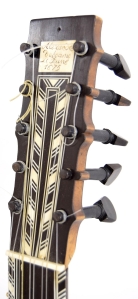 We don’t know who his teacher was, but it is thought that it could be Jean Desmoulin, another known maker from the time. At least he is mentioned in the inventory made up after Desmoulin’s death for an iou Voboam signed to him.
We don’t know who his teacher was, but it is thought that it could be Jean Desmoulin, another known maker from the time. At least he is mentioned in the inventory made up after Desmoulin’s death for an iou Voboam signed to him.
Besides the name René we also find the names Jean, Jean Baptiste, Alexandre and (Nicolas-)Alexandre Voboam. What to make of this? Thanks to extensive archive work of musicologist and organologist Florence Gétreau we now know René had two sons and three daughters. Both sons, Jean and (Nicolas-)Alexandre would become guitar makers like their dad. The latter became father to the guitar maker Jean-Baptiste who would have a son called Jean-Jacques, the last maker of the clan. Not too much is known about the first mentioned Alexandre “l’Aine” (the Elder), but it is suspected he was a brother of René.

The family probably lived and worked in Paris, in the arch-parish of Saint Mediq (St Merri), not far from the Notre Dame and the Louvre.

One of the reasons the family is so well-known is the amount of surviving guitars. Where you can count the guitars of most other makers on one or two hands, there are at least 29 of them in various museums around the world. The largest collection is in the Paris Music Museum, but you can also find them in New York, London, Vermillion (South Dakota), Washington, Geneva, Boston, Vienna, St. Petersburg, Nice, and some private collections.

And until to a few years ago in the Gemeentemuseum in The Hague. But unfortunately, the museum is neglecting its musical instrument collection, which made that the family that gave it on loan to the museum asked to have it back. They brought it to auction and it was sold to an unknown private buyer.
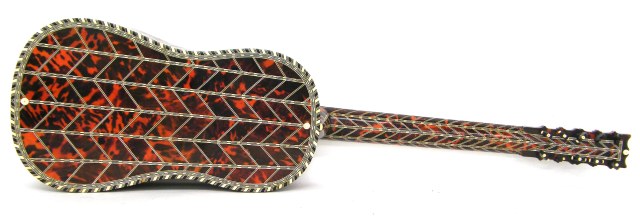
Rich and noble patrons

Portrait of Monsieur Aublet Guillaume Voiriot – ca.1782
The Voboam family lived in a time when the guitar gained in popularity. Sun king Louis XIV himself was an avid player. When the Italian virtuoso, composer and professional gambler Francesco Corbetta settled in Paris in 1654, France was in for a guitar-boom.
Courtiers at Versailles were killing time with all kinds of activities, guitar playing was one of them. The other was impressing other courtiers with the newest gadget or fashion whim. Creating a demand for elaborate bling-bling guitars; inlaid and veneered with precious materials and gilded parts in complex patterns. Some courtiers even let themselves be portrayed with their beloved and valued/valuable instrument.
Part of the survival of these guitars is probably their decorative quality. Even after the Ancien Regime fell to the Revolution and their owners were on their way to the guillotine, the guitars were kept. Some were even converted for the use of six strings when playing five courses fell out of fashion in the 19th century.
At school
My personal journey with these guitars started at ILSA Lutherie School in Belgium. During an introduction to the history of our craft, the Voboams passed by. This immediately caught my interest, being flunked out of becoming a history teacher the year before. In my spare time I began browsing the internet and reading up on guitar history. Collecting everything in large binders with information, which fifteen years on still serve me well.
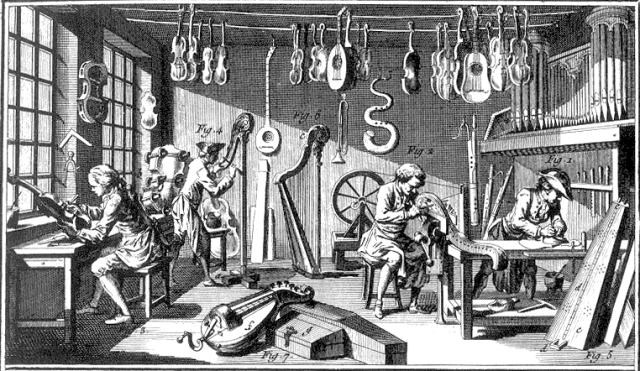
In my second year, another student in the last year decided to make a Voboam model as his final school project. School had some old plans lying around, with which he had to make do. Literally, because there was nothing else available at the time. I followed his process on foot and we often talked about it. But upon looking at the plans we came to the conclusion that there was no consistency in what we saw. A lot of small variations between the recorded instruments. All bordering roughly around the same form, but nothing exactly alike.
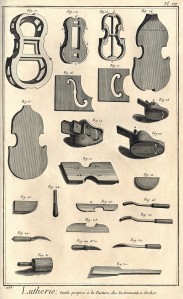
Despite that it was also hard to distinguish between original elements and later adjustments by other makers and restorers from the plans. Some of the plans were most likely intended as registrations of the guitars, never with the intention to make the instrument.
But it was even harder that there was no further information available on the subject. Shreds of information, some pictures of the museums that keep the guitars, occasional measurements, but nothing in detail or complete. A year later I found the first article by Florence Gétreau. In it she gave information on the lives and relations of the members of the family. But even better: she included a table with measurements of all surviving Voboams. One problem occurred, because there was no legend with it to show which value belonged to what part of the guitars. Thus started a nice puzzle; with the table and the plans from school I set out to match the table to the instruments. After that was done, I could get a nice overview of the dimensions of the guitars, but still there were inconsistencies.
More puzzle pieces
Because other projects asked for my attention, the Voboams went to the backburner. I occasionally looked at it, but never saw new things. Life went on, until 2010, when an article by Françoise and Daniel Sinier de Ridder brought a revelation. Shortly before the CordeFactum festival in Hingene, Belgium (where I attended the Ken Parker lectures) they published “VOBOAM: inside perspectives” on their website. An article they wrote for their book “The Guitar, Paris 1650-1950” (now sold out). In it were the conclusions of years of restoring Voboam guitars. They described how the guitars came to their workshop: “repaired” and even more ‘corrected’ by well-meaning (or at least we hope so) repairers and “restorers”. Necks shortened, barring altered, bridges replaced, metal frets, glue linings and new bars installed, etc. Everything to “strengthen” and “better” the instrument.
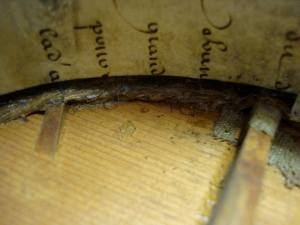
The rope in place. Photo: Françoise-Daniel Sinier de Ridder
But they also revealed something more important. That the Voboams used a glue-soaked rope as lining to strengthen the joint between the soundboard and sides. No wooden linings, just a couple of little wooden positioning cleats and the rope. The back by contrast, is attached to the sides with wooden linings. Why is this so important?
Because it meant that we have been building Voboam guitars the wrong way. Let me explain.
Different methods
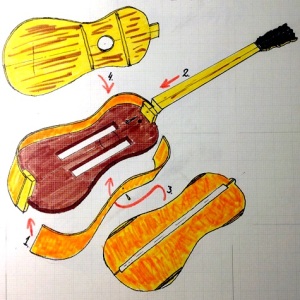
The “Italian method”
Every Voboam copy I had seen up to then was made in what I call the “Italian” fashion. The way we built violins and Italian baroque guitars (like the instruments by Stradivari and bowl backs by Sellas). Two blocks are attached to an inner form, to which the sides are glued. Then the neck is attached to the upper block, often by use of a nail or (more modern) screw. Then it’s time to install linings and the back. After which the inner form is removed and the box is closed by adding the soundboard.
But with the elements Sinier de Ridder describes, it is very hard to do it this way. How do you add a glue-soaked rope to the insides of a closed soundbox? Through the soundhole? Have you ever tried to put your hand through a soundhole to attach something inside a guitar? I have often, and it is like building a ship in a bottle. And how do you manage this with a rosette already glued in place? Trained mice? Mental powers, smoke and mirrors?
The “Spanish Slipper”
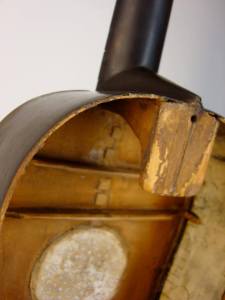
Spanish Slipper Photo: Françoise and Daniel Sinier de Ridder
They also provided another clue: something we know as the “Spanish Slipper”, “Spanish Foot” or “Spanish Volute”, an element you find in guitars constructed in the classical Spanish tradition. Like the guitars by Antonio de Torres and Ramirez. In this method you start by making the soundboard. It is put on a base plate, known as a Solera and the barring is attached. The neck and upper block form an integral piece with two slots. This is glued to the upper part of the soundboard, while the lower block is added to the other end. The sides are put into the slots of the neck and glued to the lower block. Thèn you can put the glue-soaked rope between the sides and soundboard. When this is dry and the wooden linings are in place at the other edge of the sides, the back can be glued on.
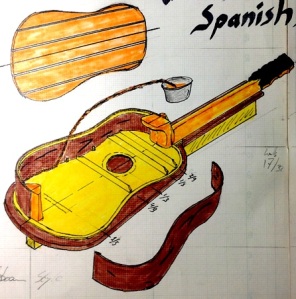
The “Spanish method”
As you can see, both processes are completely the other way around. You start the process with the step the other method ends with and vice versa. But this difference gave me an explanation for the difference between the various guitars, even by one maker. The Italian method gives very little room for variations, the inner form guides the shape. In the Spanish method you built the guitar up in the air. This gives a larger margin for variations. Especially when you bend the sides by hand it is easy to get asymmetry. I asked mr. Sinier about this at CordeFactum and he confirmed my conclusions.
One of the ironic things that I observe is that many modern makers make their Stradivari guitars with the ‘Spanish” method, and their Voboam models with the “Italian” method. Something got crosslinked here…
Towards an archetype
Another question came up: if the models evolved this way, is it possible to unlock the original, underlying design? Is it perhaps possible to use the law of averages?
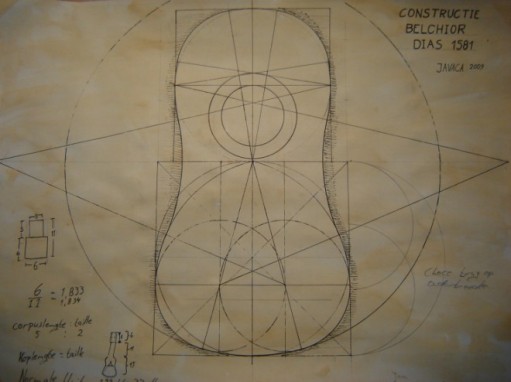
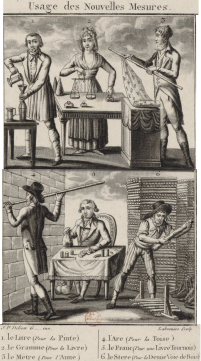
Woodcut dated 1800, illustrating the new decimal units.
I have some experience with the use of historic systems of measurement to ‘crack’ the design of instruments. For the Stradivari project I used the “Braccio da Fabbrica” of 17th century Cremona, for the Schelle theorbo the “Nuremberger Stadtfuβ”, the Roman Braccio for the Buechenberg and for the Jheronimus Bosch lute the “Bossche Voet”. For the Chambure vihuela and Belchior Dias guitar, the 16th century Portuguese Customary Units of Lisbon and so on. So, what was the unit of measurement for the Paris Ancien Regime? In school we always learned that Napoleon introduced the metric system. While that isn’t entirely true, he did demand it for the areas under French rule. Before the revolution France used the “Pied du Roi” the “King’s Foot” (324,8mm) which is divided in 12 Pouce, which in themselves are broken up in 12 Lignes. The smallest unit is the Point (1/12th Ligne or 1/1728th of a pied).

The insides of the 1665 Alexandere Voboam. Photo by Françoise and Daniel Sinier de Ridder
The unit of measurement is usually the formula or ‘key’ to unlock the design of an instrument. But for the Voboams I took a little bit of a different approach. I added up all measurements of the guitars given in the table by Gétreau, to estimate the averages. These averages were tested and corrected with the pied du roi system. From these outcomes I started to re-engineer the Voboam design. When it was finished the design and measurements were compared to the original measurements and outlines. To my surprise they come very close to the first instruments by René Voboam, the  ‘godfather’ of the design.
‘godfather’ of the design.
This basic model was used to draw a new set of plans for the Voboam style guitars. A complete system with which it is possible to make the guitars in all their design varieties. From the humbler, less decorated style found in the famous “Double Guitar” in the Vienna museum, to the most intricate designs you can imagine.
It took a while, but now it is ready. A model with which you can choose the different design options, like the Voboams did themselves.
A model suitable for both beginner and veteran builders. Ideal for schools and workshops alike. The large set of plans consists of:
- 2 basic plans (a ‘simple’ and ‘deluxe’ version)
- 6 headstocks
- 5 sets of moustaches
- 4 paper/parchment rosettes from a simple flat model to multi-level 3D
- A multitude of inlay options for back, sides, soundhole, lower block, fingerboard and binding
- An extra “Bonus Plan” of a small Voboam guitar with its rosette…
All in all, well over 250 different possible combinations… Combined with designs for cutting guides and other little tools and templates.
The most insane collection of plans I have made to date…
These plans are available through my payhip store.






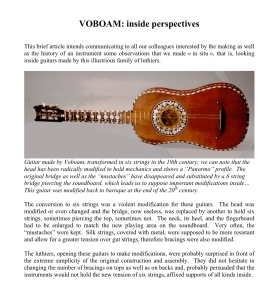
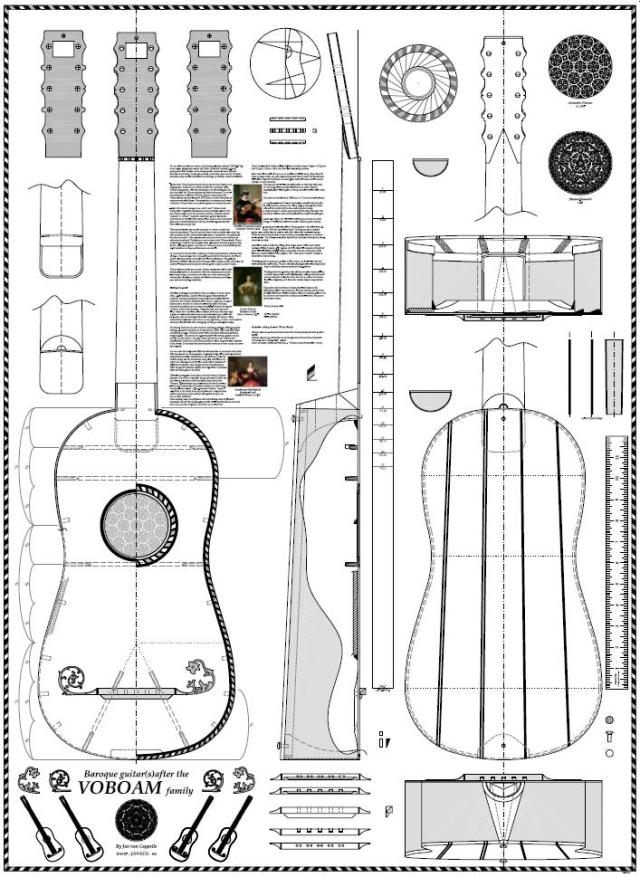
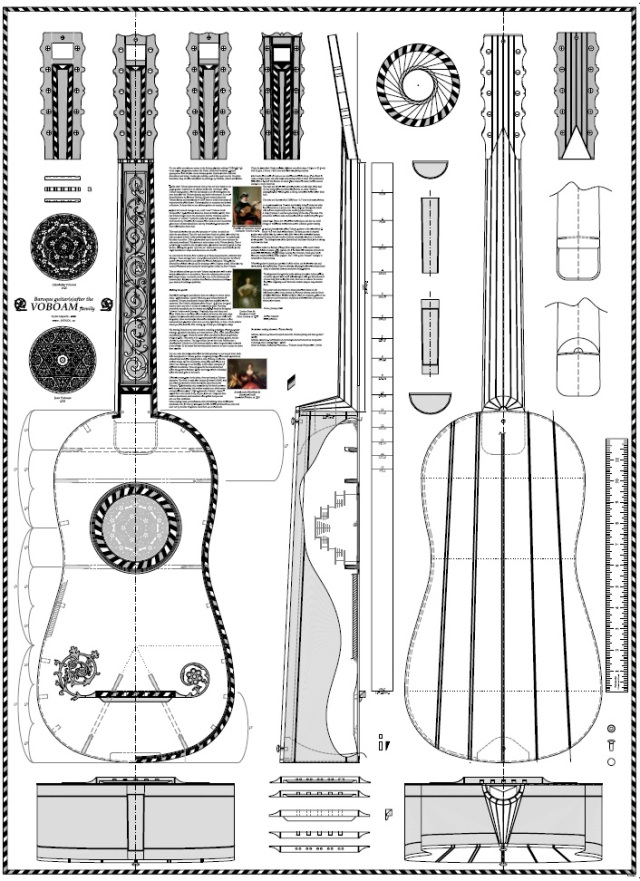
Waouh, such an incredible work! Thank you very much for sharing this for such a low price!
LikeLike